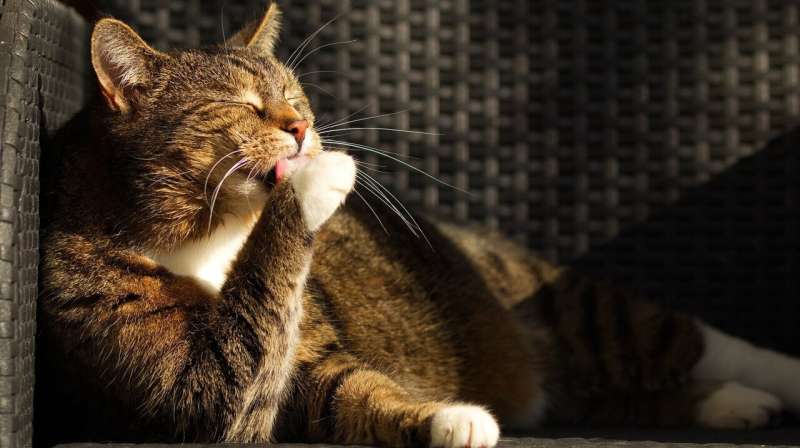This article has been reviewed according to Science X's editorial process and policies. Editors have highlighted the following attributes while ensuring the content's credibility:
fact-checked
trusted source
proofread
Recognizing compulsive disorders in dogs and cats

Pet owners may think it is adorable when their dog chases its tail or their cat suckles for comfort. But when these activities are persistent to the point that it disrupts their daily routines, it may be a sign that your pet has a more serious issue.
In humans, obsessive-compulsive disorders (OCDs) are developed when people experience obsessive thoughts, leading to repetitive, and often unhealthy, behaviors known as compulsions. Dogs and cats can also be affected by OCDs, even though they present slightly differently than the human version.
"OCDs are displayed more as compulsive behaviors in companion animals because it's unknown whether pets truly 'obsess,'" said Dr. Ashley Navarrette, a clinical veterinarian at the Texas A&M School of Veterinary Medicine and Biomedical Sciences. "There has been research that compulsive behaviors are familial and, therefore, rooted in genetics, but any dog or cat can experience compulsions because they are derived from 'normal' behaviors, persisting for a long period of time or serving no purpose."
Common compulsive behaviors in dogs can include tail chasing, licking, spinning, pacing, chewing, barking, and biting at invisible objects. For cats, it may appear as overgrooming, suckling, repetitive vocalizing, pacing, and chasing imaginary objects.
These behaviors can stimulate physical changes that calm pets, such as decreased heart rate and the release of feel-good hormones, making it hard for pets to stop. Therefore, Navarrette encourages owners to watch for common compulsive behaviors; if a pet cannot be distracted from the behavior or they return to it within minutes of the distraction, they may have a compulsive disorder.
Diagnosing compulsive disorder
One of the first steps in diagnosing a compulsive disorder in an animal is ruling out any medical conditions that may be causing the behavior. Because there is a wide range of behaviors that can be associated with the disorder, Navarrette advises owners to first take their pets to the veterinarian if they suspect their pet is exhibiting compulsive behavior.
"Compulsive behaviors are typically in response to a 'stressor,' and some levels of mental stress can escalate to physical harm," Navarrette said. "For example, a dog who repeatedly licks their leg as a soothing behavior may develop an acral lick granuloma, a skin condition that, if not allowed to heal, can lead to inflammation and infection."
"But like any behavioral issue, you have to rule out anything medical first," Navarrette explained. "For example, if a dog is compulsively licking to the extent of self-injury, a veterinarian will want to rule out any dermatological or orthopedic issues before assuming it's a behavioral issue."
Veterinarians are necessary to determine if a medical issue is not the cause, but it is up to owners to identify triggers, which typically occur right before a pet displays their compulsive behavior; however, this can be tricky since types of triggers vary greatly and can be specific to each pet.
"Triggers can include someone new visiting the house, vacuuming, or the use of laser pointers, but triggers can be anything since they are dependent on the individual dog or cat," Navarrette said. "For example, my own border collie had a compulsive behavior that involved her standing in beams of light and snapping at particles of dust. It was extremely difficult to distract her, and she would bite whatever was in front of her, which at one point included the back seats of my truck."
Owners love their pets, perhaps in spite of or because of their quirks. If those quirks begin resembling unhealthy behaviors, consulting a veterinarian is the first step in ensuring your pet lives a normal and healthy life.
Provided by Texas A&M University




















